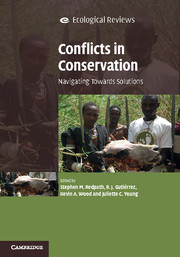Book contents
- Frontmatter
- Dedication
- Contents
- List of contributors
- Foreword by Georgina Mace
- Acknowledgements
- Part I Introduction to conservation and conflict
- PART II Contrasting disciplinary approaches to the study of conflict in conservation
- Part III Approaches to managing conflicts
- 14 Modelling conservation conflicts
- 15 Defining scales for managing biodiversity and natural resources in the face of conflicts
- 16 Mediation and conservation conflicts: from top-down to bottom-up
- 17 Designing and facilitating consensus-building – keys to success
- 18 Conservation conflict transformation: the missing link in conservation
- 19 Legislated collaboration in a conservation conflict: a case study of the Quincy Library Group in California, USA
- 20 Finding a way out of conservation conflicts
- Index
- Plate Section
- References
16 - Mediation and conservation conflicts: from top-down to bottom-up
from Part III - Approaches to managing conflicts
Published online by Cambridge University Press: 05 May 2015
- Frontmatter
- Dedication
- Contents
- List of contributors
- Foreword by Georgina Mace
- Acknowledgements
- Part I Introduction to conservation and conflict
- PART II Contrasting disciplinary approaches to the study of conflict in conservation
- Part III Approaches to managing conflicts
- 14 Modelling conservation conflicts
- 15 Defining scales for managing biodiversity and natural resources in the face of conflicts
- 16 Mediation and conservation conflicts: from top-down to bottom-up
- 17 Designing and facilitating consensus-building – keys to success
- 18 Conservation conflict transformation: the missing link in conservation
- 19 Legislated collaboration in a conservation conflict: a case study of the Quincy Library Group in California, USA
- 20 Finding a way out of conservation conflicts
- Index
- Plate Section
- References
Summary
Conservation conflicts tend to be highly complex, feed on uncertainty and affect people and organisations at different scales (Chapter 15). Traditionally, resolving these conflicts has been a ‘top-down’ process, led by governments and their official representatives, supported by scientifically trained specialists, with those affected by the conflict often relegated to the role of data-gatherers and passive recipients of information and instructions. These top-down conflict resolution processes typically seek the ‘right’ answer, as determined by national politics, laws or academic opinions. They are often framed in Western discourses about the intrinsic value of nature, over-riding older, more utilitarian values as ‘backward’ and ‘damaging’ (Zammit-Lucia, 2011). However, rather than resolve conflict, these top-down approaches have often inflamed conflict – for example, prompting violent protest or resettlement of protected areas by evicted communities (Brockington and Igoe, 2006).
In contrast to this, it has been claimed that more bottom-up, participatory approaches to controversial conservation issues have the capacity to avoid, cope with or resolve conflicts. Bottom-up approaches to resolving conservation conflicts, it is argued, have the capacity to build trust and facilitate learning among stakeholders, who are then more likely to support project goals and implement decisions in the long term (Beierle, 2002; Reed, 2008). However, there are also many critics of bottom-up approaches to conservation conflicts. For example, problems with stakeholder representation or participatory process design mean processes fail to achieve their goals or exacerbate conflict (Stringer et al., 2007; Scott, 2011). As such, it has started to be recognised that the outputs (e.g. strategies, plans or other agreements) and ultimate outcomes (e.g. social learning, network forming, preference change, implementation of solutions) of bottom-up approaches to conservation conflicts are highly dependent on the selection of participants, the process design and the context in which they are conducted (de Vente et al., in press).
Top-down and bottom-up approaches represent two opposite extremes, and in reality elements of both approaches are often combined successfully.
Information
- Type
- Chapter
- Information
- Conflicts in ConservationNavigating Towards Solutions, pp. 226 - 239Publisher: Cambridge University PressPrint publication year: 2015
References
Accessibility standard: Unknown
Why this information is here
This section outlines the accessibility features of this content - including support for screen readers, full keyboard navigation and high-contrast display options. This may not be relevant for you.Accessibility Information
- 6
- Cited by
